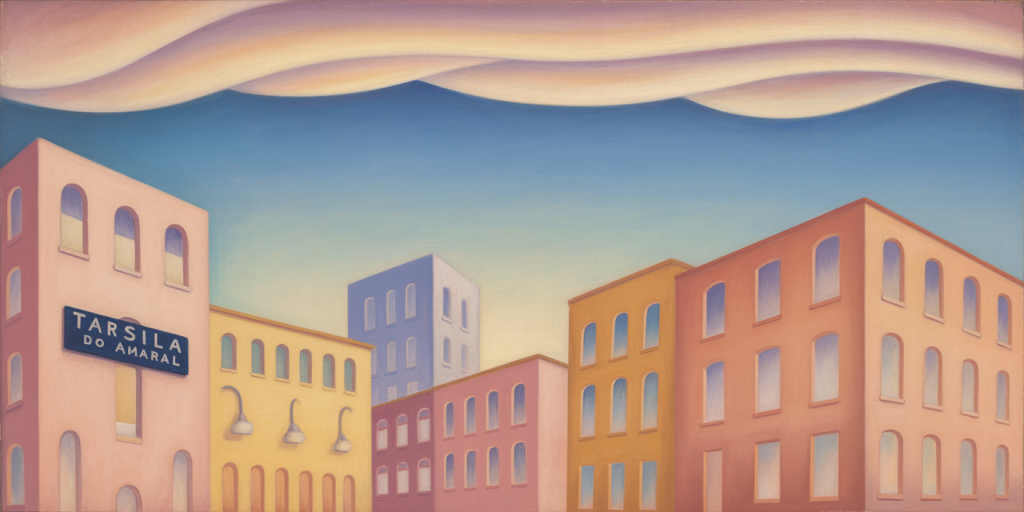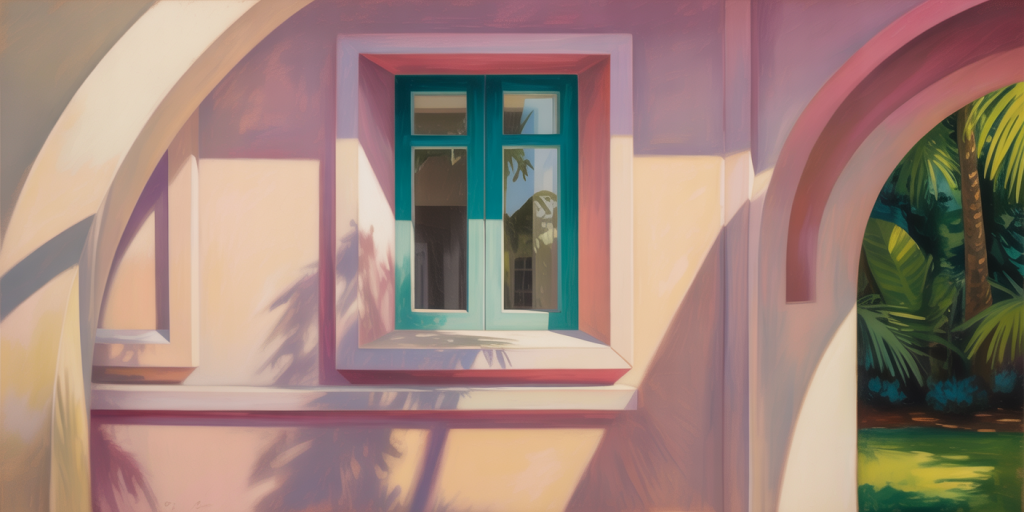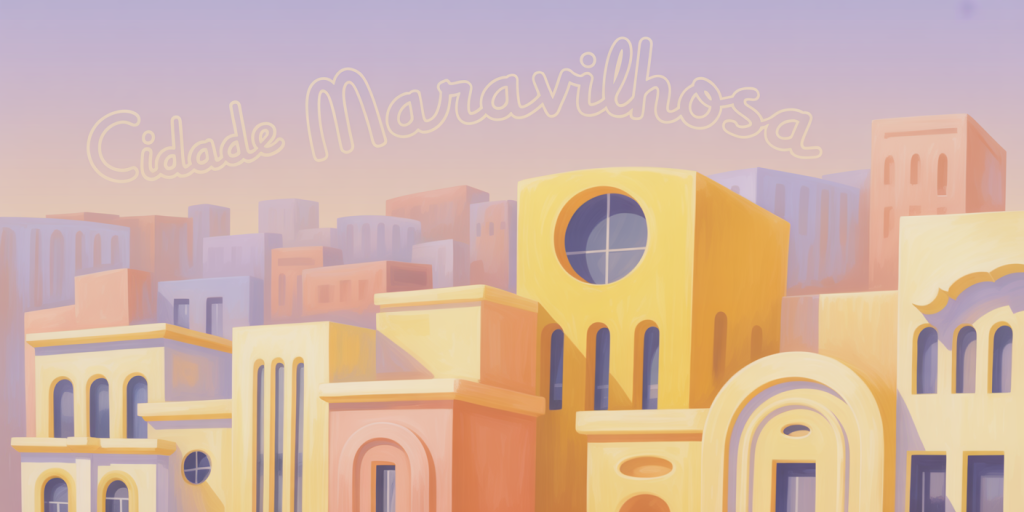The Facades Whisper Stories: Tarsila do Amaral and the Modernist Spirit of the Metropolis
There are cities that speak in traffic and steel, and others that whisper in color. In Tarsila do Amaral’s vision, the metropolis does not roar — it breathes, sighs, and suspends itself between dream and design. Her urban landscape is not noisy nor cold, but rather a collection of façades with softened edges, windows with memories, and walls that remember the sun.
This is a city reimagined by someone who listens to it. The buildings stretch like vertebrae of forgotten tales; their rooftops hold the sky like modest offerings. Tarsila does not paint architecture — she evokes its voice. And each voice is female, curved, pastel-toned, and pulsing with restrained vitality.

Poetic Table of Contents
- The Pulse Behind the Painted Walls
- Geometry Tamed by Memory
- Pastel Dialogues in Concrete
- Shadows with Sentimental Curves
- The Feminine Face of the City
- Silence in the Windowpanes
- The Stillness of a Breathing-Skyline
- Rooflines That Hold the Sky
- Texture of Forgotten Afternoons
- Compositions Built Like Lullabies
- Tropical Light with Urban Restraint
- Emotional Mapping of the Metropolis
- The Language of Symmetry
- São Paulo as Dream, Not Machine
- Symbolism in Color Selection
- When Buildings Become Characters
- Horizontal Poetics of the Street
- Nostalgia as Structural Element
- Intimacy in Monumentality
- A City That Reflects Its People
The Pulse Behind the Painted Walls
In Tarsila’s world, façades are not barriers; they are skins. Each wall contains a pulse, a rhythm that hums with contained life. You can almost hear the low murmur of families, radios, and secrets echoing behind the colors. Her brush does not divide the city — it stitches it gently.
She doesn’t illustrate space — she translates its emotional density. Her buildings lean slightly, like people caught mid-thought. The city becomes a living being, its breath rising in invisible patterns between windows.
Geometry Tamed by Memory
Unlike the cold precision of international modernism, Tarsila tames geometry with warmth. Squares and rectangles soften under her hand. Lines are never violent — they suggest boundaries rather than enforce them. Her use of form recalls memory more than mathematics.
There is calculation, yes, but it is emotional. Her compositions obey a logic of intimacy. Shapes seem chosen not for function, but for their ability to hold memory gently within them — like a grandmother’s hands holding an old photograph.
Pastel Dialogues in Concrete
Color, for Tarsila, is not embellishment. It is voice. Her pastel tones speak softly, like letters written in affection. Pale pinks, lagoon greens, twilight yellows — each tone is a phrase whispered across stucco and stone.
These hues do not imitate reality but reinterpret it through tenderness. Even concrete, under her brush, becomes capable of softness. Her palette speaks not of materials, but of emotion: the warmth of a street after rain, the sweetness of laundry on the line.
Shadows with Sentimental Curves
Shadows stretch in slow, affectionate curves. They are not sharp, but reflective — like memories brushing the edge of the day. In her city, even light obeys a gentler rhythm. It lands on surfaces as if with reverence.
These shadows do not obscure — they embrace. They suggest time passing not as a threat, but as a lullaby. The buildings are allowed to dream in full daylight, half-awake in their own histories.
The Feminine Face of the City
Tarsila’s metropolis has no steel jaws or masculine dominance. It is feminine — curvaceous, generous, maternal. Balconies become hips, doors resemble mouths mid-breath. Architecture becomes anthropomorphic, suggesting emotion without animation.
This feminine urbanity does not weaken the city — it humanizes it. The hardness of stone becomes nurturing. The spaces she constructs are inviting not because they are open, but because they are empathetic.
Silence in the Windowpanes
The windows in Tarsila’s façades are eyes without pupils. They do not look out — they reflect inward. Silence sits behind each pane, thick and shimmering, like syrup on glass.
These windows are symbols of internal life. They offer no voyeuristic access, only mystery. Their symmetry does not comfort but question. What lives behind this calm? What dreams sleep behind these silent panes?
The Stillness of a Breathing Skyline
The skyline in Tarsila’s painting is not aggressive. It rises like a breath — gentle, patient, unwavering. There are no towers of dominance, no competition for height. Her buildings exist in dialogue, not battle.
The result is a city that breathes. Its rhythm is steady and slow, like someone asleep under cotton sheets. In this stillness lies a powerful defiance: the refusal to rush.
Rooflines That Hold the Sky
Her rooftops curve and taper like hands cradling the sky. They do not pierce it. They hold it carefully, as if sky and structure were old friends, reluctant to part.
There’s spiritual generosity in these roofs. They are not ambitions — they are gestures. The city holds the heavens not as conquest, but as communion.
Texture of Forgotten Afternoons
One can almost feel the rough stucco under sunlight, the humidity trapped in yellow paint. Tarsila’s brushwork invokes tactile memory. Her surfaces are more than seen — they are touched.
These textures carry echoes: the scrape of a broom, the creak of a shutter. Each façade whispers stories not just through form, but through its imagined materiality.
Compositions Built Like Lullabies
Tarsila composes her scenes with the softness of a lullaby. Balance is not rigid — it flows. Each element seems to sway gently, creating harmony through suggestion.
Her paintings do not command attention. They invite you to linger, to rest your eyes. The viewer becomes part of the hush, rocked by rhythm rather than dazzle.
Tropical Light with Urban Restraint
Tarsila’s light is unmistakably tropical, yet never flamboyant. She controls brightness with sophistication. There are no glaring whites, no blinding yellows — only the golden warmth of restraint.
Light becomes architectural in itself. It defines space subtly. It allows the viewer to feel the sun without being scorched. It allows the city to glow without boasting.
Emotional Mapping of the Metropolis
The city here is not a plan — it is a feeling. The map that Tarsila draws is emotional, not geographic. Each building stands not in real space, but in memory, in longing.
She does not render São Paulo as it is, but as it is remembered — softened by time, colored by affection, framed by nostalgia.
The Language of Symmetry
Symmetry, in Tarsila’s hands, is poetic. It is not perfection, but peace. Her buildings often mirror one another in quiet choreography, creating rhythm and comfort.
But this symmetry is not mechanical. It is human. It feels like the repetition of breath, the echo of footsteps down a quiet street. Balance becomes language — a way for façades to converse.
São Paulo as Dream, Not Machine
This is not the industrial São Paulo of gears and smoke. It is the dream São Paulo — imagined by someone who knows its weight and chooses its softness.
Tarsila removes the noise and keeps the soul. Her city is not an engine. It is a body, a memory, a lullaby. And because of that, it feels more real than any blueprint.

Symbolism in Color Selection
Every color carries a whisper. Blue suggests silence, pink hints at emotion, green evokes longing. Tarsila’s palette is her lexicon — each hue a carefully chosen word.
She does not chase contrast. She creates continuity. Her colors do not shout — they murmur. And those murmurs become meaning.
When Buildings Become Characters
Each structure has personality. Some are shy, receding in tone; others lean forward, eager to speak. There is no anonymity. Every wall has a story. Every window, a pause.
Tarsila humanizes architecture not through decoration, but through empathy. She gives façades emotion without movement — a rare, delicate skill.
Horizontal Poetics of the Street
While modernism often glorifies the vertical, Tarsila sings the horizontal. Her city stretches, breathes, sprawls like a siesta. Her visual poetry lies not in height, but in spread.
Horizontality here is calm. It invites the viewer to walk slowly, to read each segment like a verse in a long urban poem.
Nostalgia as Structural Element
There is a veil of saudade over her architecture — not sadness, but tender distance. These buildings do not mourn the past, they remember it fondly.
Nostalgia is not a mood here — it’s a building block. The entire city seems constructed from longing and memory, from moments held longer than they lasted.
Intimacy in Monumentality
Despite their grandeur, Tarsila’s structures feel intimate. They do not intimidate. They invite. Their size holds not power, but protection. They are not monuments — they are companions.
Even the tallest walls seem to lean down and listen. The city becomes less a place and more a presence — maternal, steady, attentive.
A City That Reflects Its People
In the end, Tarsila paints not just São Paulo, but its soul. A city is nothing without those who live within it, and she reminds us of that. Each door, each window is a mirror.
This city is not about domination, but belonging. It does not impose itself — it opens. And in that opening, we see ourselves.

FAQ – Questions and Answers
Who was Tarsila do Amaral?
Tarsila do Amaral was a pioneering modernist painter from Brazil, central to the Anthropophagic Movement and the cultural reimagining of Brazil in the early 20th century. Her work fuses local identity with avant-garde techniques.
What is the significance of her urban paintings?
Tarsila’s urban works reimagine the city not as industry or chaos, but as an emotional, poetic space. They challenge cold modernism by proposing a humanized, lyrical vision of Brazilian architecture and life.
How does Tarsila use color in her compositions?
She uses pastel tones and tropical hues not for decoration but for emotional expression. Her color choices carry symbolic and psychological weight, defining mood and voice rather than mere aesthetics.
Why are her buildings depicted with such softness?
Tarsila softens form to evoke intimacy. Her buildings become characters, reflecting the lives within them. This approach contrasts with rigid modernism and emphasizes empathy over spectacle.
Is the city in her paintings real?
It is inspired by São Paulo, but filtered through memory, imagination, and dream. The result is an emotional cityscape — a symbolic reflection of Brazilian urban experience.
Final Reflections – The City Beneath the Colors
Tarsila’s façades do not hide — they whisper. They murmur fragments of stories, pieces of time, and traces of lives lived slowly. Her city is not made of asphalt and noise, but of quiet affection, remembered warmth, and pastel dreams.
She invites us not to analyze but to feel. To walk her painted streets not with our feet, but with our breath. And in doing so, we discover that buildings too have emotions — and that cities, when truly seen, are nothing but stories wearing walls.
